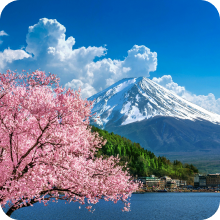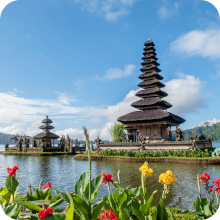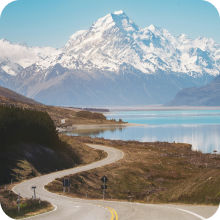Does It Snow in Japan? In-depth Exploration for Adventurous Traveler
"Does it snow in Japan?" This question has been tumbling around the collective travel-enthusiast consciousness more often than a snowball down a Hokkaido hillside. The answer, my intrepid reader, is an emphatic yes! Japan, dear friends, is not just a land of Sakura blossoms and anime - though they are certainly charming - it also graces its northern and mountainous regions with a delicate blanket of snow in the winter months. It's a real-life Winter Wonderland, and we're not talking the Michael Bublé kind. So, sit back, sip your warm sake (or your hot cocoa, I don't judge), and let's embark on a journey of wintry discovery.
Table of Contents
- Japan's Unique Climate and Weather Patterns
- Regions in Japan Where It Snows
- Snow in Northern Japan: Hokkaido and Tohoku
- Snow in Central Japan: Japanese Alps and Kanto Region
- Snow in Western Japan: Sea of Japan Coast
- Best Times to Experience Snow in Japan
- Early Winter Snowfall: November to December
- Peak Winter Snowfall: January to February
- Late Winter Snowfall: March to April
- Preparing for a Snowy Trip to Japan
- Embracing the Winter Culture in Japan
- Onsen Culture: Hot Springs in Cold Weather
- Winter Food: From Ramen to Mochi
- Illuminations and Festivals
- Frequently Asked Questions (FAQs)
Japan's Unique Climate and Weather Patterns
When one thinks of Japan, images of blooming cherry blossoms, towering skyscrapers, and platefuls of sushi might come to mind before a wintry landscape does. But lo and behold, Japan's climate is as diverse as a Haruki Murakami novel.
The Four Seasons in Japan
Like a well-constructed haiku, Japan appreciates the profound nuances of its four distinct seasons. There's the pink haze of cherry blossoms in spring, the sweltering heat of summer days, the vibrant canvas of autumn leaves, and, of course, the snowy spectacle of winter.
Winter in Japan, usually from December to February, is when many regions don the ethereal blanket of snow. It's like Narnia, but instead of a wardrobe, you're just a flight away.
Impact of Geographic Location on Japan's Climate
Japan, like a reclining dragon, stretches from the northern subarctic climates to the southern subtropical zones. The chilly kiss of winter is felt more passionately in the northern regions, such as Hokkaido and Tohoku, and the mountainous areas, courtesy of the Japanese Alps. Meanwhile, cities like Tokyo, more to the south, might occasionally see snowfall, but it's rarer than a quiet moment in the Shibuya Crossing.
The Sea of Japan side of the country, thanks to cold Siberian winds blowing across warm currents, witnesses heavy snowfall, famously known as 'yukiguni,' or snow country. Yes, you read it right. A country within a country, an Inception of snowy delight!
So, does it snow in Japan? It's a resounding yes! But where, you ask? Allow me to guide you through some winter paradises that could give Elsa's Arendelle a run for its money.
Regions in Japan Where It Snows
Now that we’ve established that Japan is indeed a destination for snow seekers, let's dive into some specifics, shall we? If you're looking for the most snow-blanketed landscapes that make you feel like you've walked into a scene from Game of Thrones (minus the White Walkers, thankfully), then some regions should top your travel list.
Snow in Northern Japan: Hokkaido and Tohoku
In the far reaches of Japan's north lies Hokkaido, a place so snowy, it would leave Jon Snow feeling right at home. Its capital, Sapporo, famous for its beer and Snow Festival, can receive snowfall up to 6 meters in depth. That's about two Shaquille O'Neals stacked on top of each other! Imagine building a snowman of that size!
Tohoku, further down, isn't shy of snow either. This region presents an enticing balance between urban life and untouched nature, especially in winter. Places like Yamagata and Akita receive copious amounts of snow, offering fantastic opportunities for winter sports and onsen-hopping. Remember the snow monkeys in hot springs? This is where you can join them, just remember your manners, and please, no splashing!
Snow in Central Japan: Japanese Alps and Kanto Region
The Japanese Alps, a scenic spectacle that would make even the Swiss Alps blush, experience significant snowfall too. Regions such as Nagano, Gifu, and Toyama are blessed with fantastic skiing resorts, idyllic winter views, and traditional villages like Shirakawa-go. This UNESCO World Heritage site with its gassho-zukuri farmhouses, doused in thick snow, is as close to a winter fairytale as you can get without tripping over the Grimm Brothers.
And then, of course, we have the Kanto region, home to Tokyo. While snow isn't as regular a guest here as in Hokkaido, when it does arrive, it creates a charming tableau - imagine snowflakes falling softly against the neon glow of the city. It's as poetic as a Basho haiku!
Snow in Western Japan: Sea of Japan Coast
The Sea of Japan Coast isn't just about picturesque sunsets, my friends. As I mentioned earlier, it's also known as 'yukiguni,' the snow country. Areas like Niigata and Kanazawa receive heavy snowfall due to the 'lake effect' snow from the Sea of Japan, making them paradisiacal for snow lovers.
So, in the timeless words of Bing Crosby, let it snow, let it snow, let it snow!
Best Times to Experience Snow in Japan
Equipped with a basic understanding of the when and where of Japanese snow, it's time to get down to the nitty-gritty. When should you pack your thermal undies and embark on your snowy adventure to the Land of the Rising Sun? Let's find out.
Early Winter Snowfall: November to December
For those of you who've been dreaming of a white Christmas, Hokkaido in late November to December could be your answer. Sapporo and Niseko begin to resemble scenes out of a Hallmark Christmas movie, all decked in their winter finery. Early snowfall also signals the opening of ski resorts, offering immaculate, powdery slopes to carve up before the peak crowds arrive.
Peak Winter Snowfall: January to February
Roll up, roll up! For those in search of the real winter spectacle, January to February is the grand carnival of snow. The northern and western regions are at their snowy peak during this period.
In addition to the typical winter activities like skiing and snowboarding, there are also unique cultural events such as the Sapporo Snow Festival. Imagine sculptures of everything from Star Wars characters to historical Japanese landmarks, all made from snow and ice! It's a regular Disneyland for the snow enthusiasts, minus the long lines and overpriced popcorn.
Late Winter Snowfall: March to April
The party isn't over yet, snow fans! March still sees snowfall in Hokkaido and the Japanese Alps, while cherry blossoms start to bloom in the southern regions. It's a heady combination of spring and winter, a clash of seasons akin to a Marvel Cinematic Universe crossover event.
So, whether you're an early bird catching the snowflakes, a peak season adventurer, or a late winter wanderer, Japan's got a winter wonderland waiting for you.
Preparing for a Snowy Trip to Japan
Now that we've navigated the who, what, where, and when of Japan's wintry landscape, it's time to tackle the all-important how: How to prepare for your snowy trip to Japan.
Essential Clothing and Gear
Layering is your best friend here. Think onions, but without the tears. Thermals, woolen sweaters, waterproof outer layers, and don't forget the hats, gloves, and scarves! For your feet, waterproof boots are a must to keep those toes toasty.
And what's more essential to a snow trip than gear for some fun in the snow? Skis, snowboards, sleds, or even a good old fashioned carrot for your snowman's nose - pack according to your planned activities. For those less inclined towards the adrenaline-pumping sports, a good book by the fireside is a packing essential. May I recommend my favorite, "A Walk in the Woods"?
Travel SIM Cards: Staying Connected in Japan's Winter Wonderland
Now, let's talk tech. In an age where we're more connected than ever (I mean, you’re reading a blog about snow in Japan, how wild is that?), staying in touch during your travels is essential. Whether you want to Instagram your snowy escapades, navigate the labyrinthine streets of Tokyo, or just call home to say "Konnichiwa," a good Travel SIM card is crucial.
Enter SimsDirect. With their superb range of Travel SIM Cards for Japan, you'll stay connected faster than you can say "kawaii." Easy to use, with fantastic coverage even in snowy regions, it's like having a reliable friend in your pocket. So, while you're busy making snow angels or singing Frozen's 'Let it Go' at the top of a mountain, SimsDirect has got your connectivity covered.

Embracing the Winter Culture in Japan
The magic of a snowy adventure in Japan lies not just in the icy landscapes and powdery ski slopes, but also in embracing the unique winter culture. It's time to deep-dive into some of the winter wonders of Japanese culture that could make even a Hoth Wampa feel warm inside.
Onsen Culture: Hot Springs in Cold Weather
Remember the cheeky snow monkeys basking in hot springs? Well, they're onto something! Japan is abundant with onsens (natural hot springs), providing a blissful haven from the frosty weather. Picture this: you, immersed in a hot, soothing spring, surrounded by snow-clad landscapes. It's like bathing in a hot tub, only Mother Nature's running the show.
Do note, there are specific onsen etiquette to follow, so brush up on those before you dip in. And don't worry, most onsens are separated by gender, so there won't be any awkward encounters à la Chandler and Joey's infamous bath!
Winter Food: From Ramen to Mochi
Japan's winter cuisine is as heartwarming as a Studio Ghibli movie. Savor a bowl of piping hot ramen, or indulge in nabe (Japanese hot pot), a communal dish perfect for socializing on chilly nights. For dessert, nothing beats warm mochi with a steaming cup of matcha. It's like a hug from the inside, just what you need after a day in the snow.
Illuminations and Festivals
In the immortal words of ABBA, Japan knows how to take a chance on the winter night, and dance! Winter illuminations light up cities across the country, creating a spectacle that could rival the Northern Lights. Festivals such as the Sapporo Snow Festival and the Shirakawa-go Light-Up Event turn the already picturesque landscapes into a dreamscape, right out of a Tim Burton movie.
So, whether you're soaking in an onsen, tucking into hearty winter cuisine, or gasping at the stunning illuminations, experiencing Japan's winter culture is bound to leave you with a warm glow and memories as precious as a coveted Pikachu card.
Thanks for visiting our blog, are you planing to travel to Japan? Check out our Japan SIM Card.
Before you take off make sure to check with local government of the travel status.
Frequently Asked Questions (FAQs)
Before we wrap up, let's address some burning questions you might have. After all, I'm here to enlighten, just like Yoda did with Luke (but thankfully without the swampy training ground).
1. Is it easy to travel around Japan in the snow?
Indeed, it is. Japan boasts an efficient and extensive transportation network that doesn't cower in the face of a little (or a lot of) snow. Trains, buses, and planes continue to operate, albeit with potential delays during heavy snowfall. And trust me, watching the snow-capped landscapes whiz by from a Shinkansen window is as thrilling as the final Harry Potter Quidditch match!
2. Is snow in Tokyo a common occurrence?
While Tokyo does receive snow, it's not as common or as heavy as in regions like Hokkaido or Tohoku. But when it does snow, the contrast of Tokyo's bustling, modern landscape adorned with a blanket of white is as enchanting as a Murakami novel.
3. What activities can I do in Japan during winter?
Well, where do I begin? Winter sports like skiing and snowboarding, snow festivals, winter illuminations, soaking in onsens, food tasting tours - the list is as long as a Tolstoy novel. Just remember to pack the right gear and embrace the cold!
4. What should I pack for a trip to Japan in winter?
Thermals, woolen sweaters, waterproof outer layers, hats, gloves, scarves, waterproof boots, and any gear you need for snow activities. And of course, your SimsDirect Travel SIM Card to stay connected on your snowy escapades.
5. How cold does it get in Japan during winter?
It varies by region. In Hokkaido, temperatures can plummet to -20°C, while in Tokyo, it hovers around 2°C to 10°C. It’s a mixed bag really, like a packet of Bertie Bott's Every Flavour Beans.
That's a wrap, folks! I hope this snowy guide to Japan has given you enough inspiration to start planning your winter adventure. Remember, every snowflake is unique, and so is every traveler's journey. Now, it's your turn to make some 'cool' memories in Japan!









